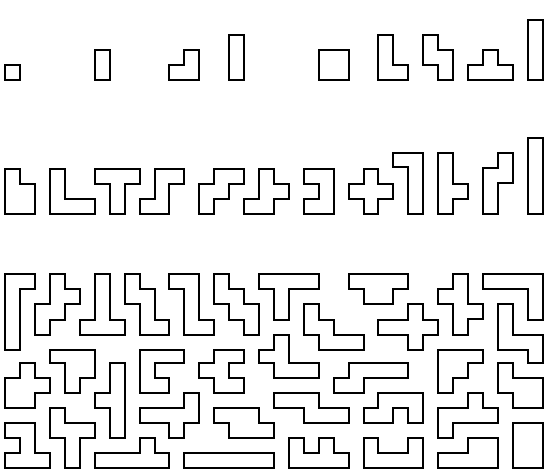
[Home] [Contents] [Figures] [Search] [Help]
[Next Page] [Prev Page] [ Next Chapter] [Prev Chapter]
Continuing in the same vein, we now consider squares as building blocks (Fig. 28), with the number of pieces summarized in Table 2.
Fig. 28
Table 2
When we compare this summary with that for the triangle, the much greater versatility of the square as a combinatorial building block is apparent. The various pieces are popularly referred to as polyominoes after a book on the subject with that title by Solomon Golomb. The various sets of pieces have been the object of much investigation by mathematical analysis. Note that much of this analysis is concerned with proving mathematically where such pieces will or will not fit, which may or may not have much relevance to the design of practical geometrical puzzles.
Incidentally, the listing in Table 2 and others like it have been calculated for pieces of much larger size, often using a computer. Such pieces have little practical value in dissection puzzles beyond a certain size, the elegant simplicity of discrete dissection becomes obscured by complexity, going against the natural human inclination to reduce all things to their simplest and most functional common denominator. In combinatorial recreations of this sort, those that achieve their intended object using the fewer and simpler pieces are nearly always the more satisfactory.
The most obvious constructions for polyomino puzzle pieces are square or rectangular assemblies. If complete sets are being considered, then Table 2 suggests that only the size-four and size-five sets look interesting. First we will dispose of the size-four set. If the reader will mark and cut the five size-four pieces out of cardboard, it should be easy to convince oneself that it is impossible to assemble them into a 4 x 5 rectangle. But how can you be sure? This problem will be used as a simple example to illustrate two common analytical approaches to puzzles of this type.
Mark a 4 x 5 board on paper. Start with the straight piece and note that there are 13 different positions it can occupy on the board. But because of symmetries, only five are distinctly different. Of these five (shown in Fig. 29), three can immediately be eliminated by inspection. The remaining two can be analyzed by placing a second piece, the square, in all possible positions and seeing what problems then arise. When one uses this method, a judicious choice of the first piece may save many steps. Usually a symmetrical piece is the best choice because there are fewer distinctly different ways that it can be placed.
Fig. 29
An alternate technique frequently used for analyzing problems of this sort is the following: Note that if the 4x5 board is checkered, it will always have 10 light and 10 dark squares. Now checker the pieces and note that four of them will always have two light and two dark squares, but the fifth will always have three of one color and one of the other (Fig. 30). Consequently, they will never fit onto the board.
Fig. 30
| ©1990-2005 by Stewart T. Coffin For questions or comments regarding this site, contact the chief metagrobologist: |
[Next Page] [Prev Page] [ Next Chapter] [Prev Chapter]